-
Saying Goodbye to Yang by Alexander Weinstein
I watched the film After Yang from 2021 directed by Kogonada and I liked the general premise of the story, though I did home issues with the film. This story from 2010 is what the film is based on and served as a great introduction to this unknown to me author.
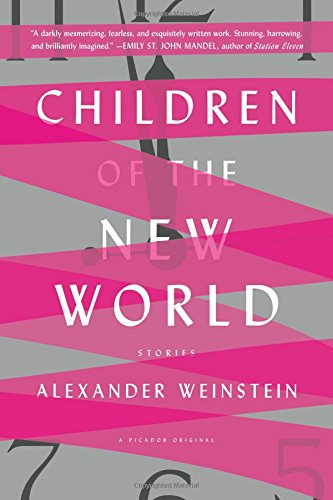
Set in a near future where both clones and androids exists, though there seems to be an undertone of a form of racism and conflict between people using those two forms of artificial humans. The story follows a normal family who has an adopted girl and the android Yang who functions as a sort of big brother. One day Yang breaks down and the father is desperate for getting it repaired, but Yang is out of warranty.
This story is more about the premise and background worldbuilding than the actual plot. The backdrop with a future society with new forms of prejudice was nicely done and parallels to present day issues are easy to draw. The film adaption adds extra elements that works both to its detriment and benefit, but this short story definitely made me want to read other stories by Weinstein.
Read in Children of the New World
Originally published in Zahir, #22, April 2010
Rating: 3+ -
Five Hundred KPH Toward Heaven by Matthew Kressel
Space elevators is one of those cool science fiction concepts that you hope might actually become real one day. But even future advancements in technology will be obsolete at some point and operations will be shut down.
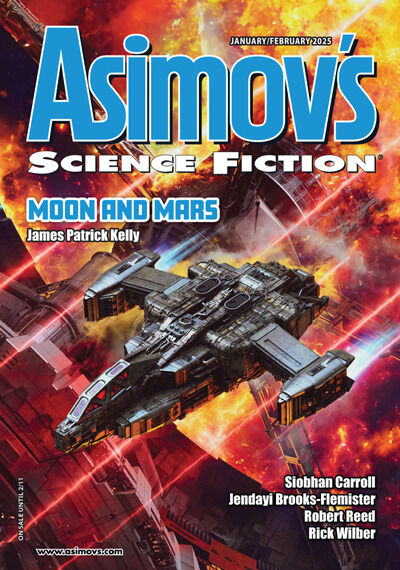
The premise of this story is a farewell party on a space elevator as the company is shutting down its operation as it has been unprofitable for years and overtaken by a new type of faster and cheaper spaceship. People who have worked on the space elevator for many years share stories and have general reminiscent conversations.
Not much really happens, though we do get one dramatic story told by our protagonist, but it is generally a pleasant read that has a nostalgic feeling despite being about a future technology.
There is also an interview with the author on the magazine’s blog From Earth to the Stars.
Read in Asimov’s January/February 2025
Rating: 3 -
LuvHome™ by Resa Nelson
Stories about machines that are programmed to protect humans against ourselves goes far. Reading this humorous little story I was reminded of “With Folded Hands” by Jack Williamson from 1947, but this isn’t nearly as sinister.
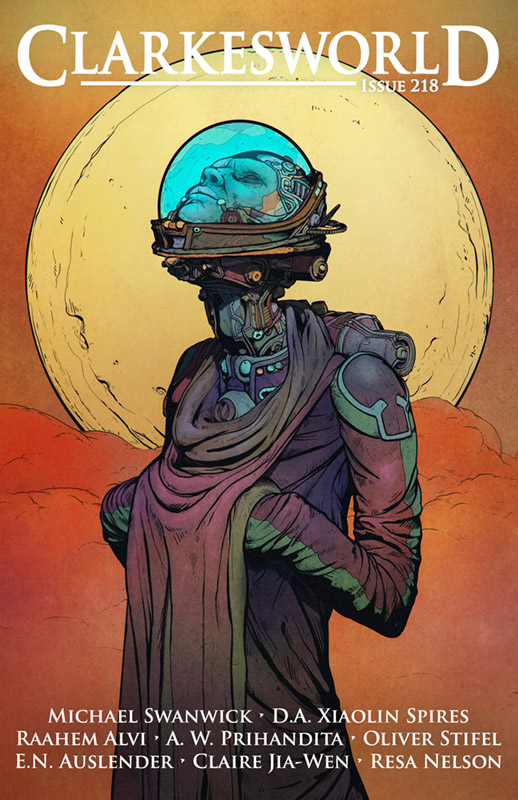
Dyna has fitted her condo with an AI program of sorts, called LuvHome, and it has been configured to improve her life and given authority to do so with any means necessary. The story starts where it has locked her out of her apartment in what it says is her own best interest:
“Already spelled it out, nice and proper in the paperwork you signed when you bought me. But to get more specific, you need to get out and meet people. Eat food that’s good for you. And get some exercise. You’ve done yourself no good by lying around all day doing nothing but eating junk. That’s all you’ve done ever since moving in. I’ve had a chat with the places that deliver your takeout meals, and they’ve agreed to ignore your future orders. I’ve told them what to send instead.”
Dyna is furious and goes to the police who can’t help her because she bought and agreed to the LuvHome installation. So she is forced to actually be outside for a bit and meet new people, and that is pretty much the story.
It is very straight forward with its setup and conclusion, all told in a screwball like comedy tone. I was actually a bit surprised that the point of the message wasn’t, at least not obviously, a critique of machines controlling our lives. More like the opposite as LuvHome is shown to basically be right in forcing her to go outside.
Neat little story that will put a smile on most peoples faces.
Read in Clarkesworld November 2024
Rating: 3 -
Unquiet Graves by Michael Swanwick
Swanwick delivers a pretty short story filled with black humor about a man who visits digital copies of his deceased father and wife.

It is a future where people have the option to be resurrected using their digital copies. Massey has a body he wants to resurrect his wife Jenny into. However she is not pleased with that and their disagreement leads to Jenny revealing a sinister truth about how they died.
There are some pretty interesting concepts presented by Swanwick in this story and it raises interesting ethical questions about dealing with consent and rights for dead people with this sort of technology. However, I think the story goes over it all too quickly. It mostly lead up to the big reveal and then stops, with little time to go really deep into the issues or give any of the characters much depth. It might make a decent Black Mirror episode though.
Read in Clarkesworld November 2024
Rating: 2 -
The Coffee Machine by Celia Corral-Vázquez
This story is originally published in Spanish in 2019 and here translated by Sue Burke. It is a rather humorous story about various appliances such as coffee vending machines and parking meters gaining conciousness as they try to make sense of the humans they can observe.
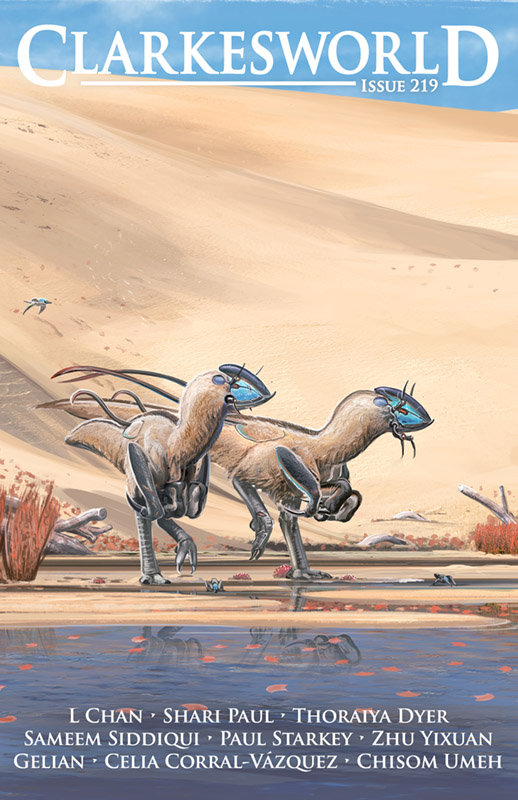
The short story starts with something made that is meant to resemble the internal programming language of such vending machines like:
input: options = cappuccino; sugar = 3;
if (input == (options = cappuccino; sugar = 3) ) {
output: combine (coffee (milliliters = 150; type = 3), milk (milliliters = 50; type = 1), sugar (level = 3) );
serve (output);
}
As the story progresses and the machines gets self-concious it gradually turns into more normal conversations. My profession likely gets in the way of the intent here, but I did find the use of pseudocode to a little annoying and it went on a bit too long.
As the machines gains conciousness their observations and faulty conclusions on human behavior is for the post pretty funny, though that is of course very much up to personal taste when it comes to jokey dialogue. I didn’t get the reasoning or what the joke was supposed to really be when the machines made Netflix some kind of god, but I did enjoy their internal bickering and mockery.
Like this small passage:
network_broadcast [PARKING_METER.31]: Machines with a serial number equal or less than 10 are inferior to us in every aspect. And worse, you are an even number.
network_broadcast [COFFEE_VENDOR.06]: What? How is that a thing?
network_broadcast [PARKING_METER.31]: Because it is. Shut up, two-bit machine.
network_broadcast [COFFEE_VENDOR.06]: Just what I needed. Does anyone else have another reason to savage the rest of us? No one? Worshipers of the USB that goes in on the first try? Followers of the cuckoo clock?
As the story is fairly short, the machine uprising comes and goes very quickly and while the story does deal with bigger themes like the complications of artificial intelligence, and a reflection on how quickly factions can form and turn against each other, it is still just a slight humorous piece.
Read in Clarkesworld December 2024
Rating: 3 -
Dead Worlds by Jack Skillingstead
This story starts with a man driving on a road in the woods at night where he hits and kills a dog. The owner is close by and they walk back to her house with the dead dog. Through small details and conversations we get to know that the man has been part of some strange government experiment involving a planet light years away, and he now has to take special medication to function “normally”.
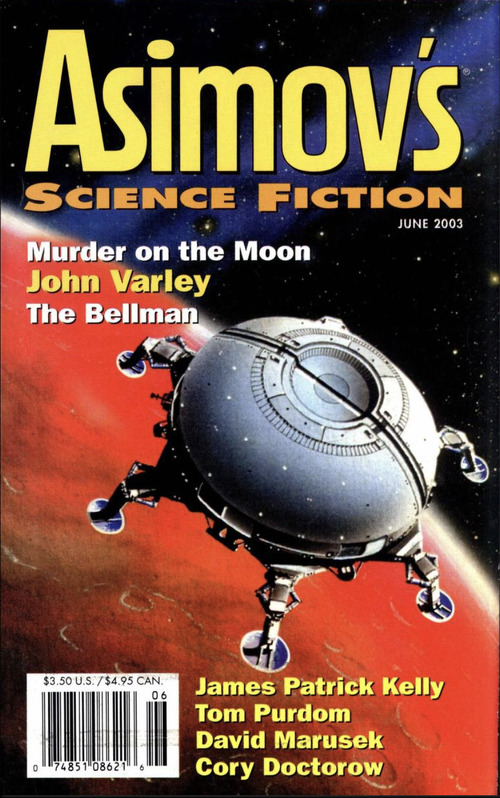
Not much really happens in the story itself, as the meat is within the mysterious backstory and the rather dire personal consequences for the protagonist. It is beautifully written and I was fully engrossed from start to finish. It also covers one of my favorite story themes with a loss of identity and personality.
The story is not very long but Skillingstead manages to give a very detailed and interesting portrait of these two people, their background, their emotional state and make their connection seem real. Which all play well together with an unique science fiction concept, but it is not a story that provides answers or resolutions. It is open-ended and open for interpretation, which sometimes can be really frustration but I loved it here.
Read in Forever Magazine, December 2024
Originally published in Asimov’s June 2003
Rating: 4 -
Death of an Intelligence by Mjke Wood
In a couple hundred years artificial intelligences have created an utopia without crime or suffering. But what do you do when a murder on an AI happens and there is no such thing as police investigators? You hire a history professor who has studied ancient detective novels.
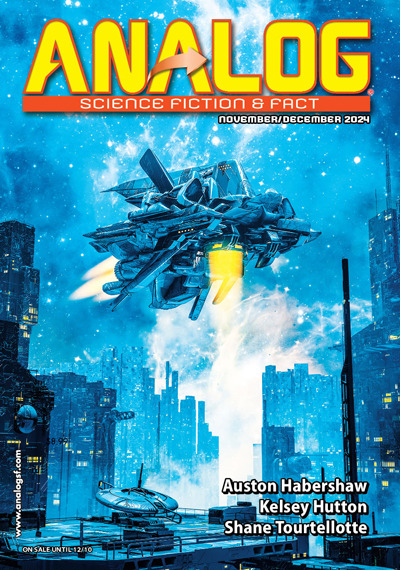
The story follows professor Petri and Alyssa in their investigation into a mysterious sabotage of an artificial intelligence. Or just “intelligence” as the term “artificial” is considered rude at this point. Apparently somebody messed with the cooling system and there are only three potential suspects.
The structure is the classic detective procedural where the professor seemingly have solved the case almost immediately, but now must go through the usual motions for the sake of the apprentice - and the reader. For what it is, I think it is fairly well written and slightly amusing, with some interesting tidbits here and there giving a hint on what sort of future we are in here.
Read in Analog November/December 2024
Rating: 3 -
Nugget by Joseph H. Delaney
A small mining spaceship is floating around the Oort cloud, when it detects an asteroid that could contain valuable minerals. But when they haul it in, the math doesn’t add up with its total mass and it is messing up their Newtonian physics calculations for the spacecraft.
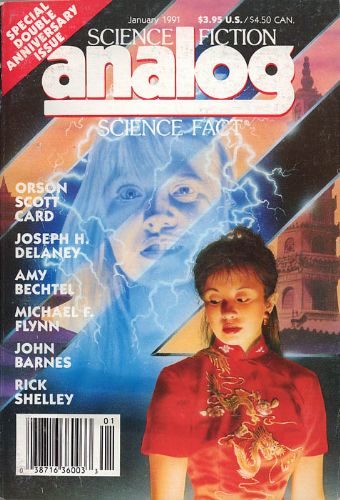
It is an intriguing setup for a story, where a small crew tries to deal with something that is beyond their scientific capabilities, but they know they have something special on their hands. The story follows a familiar plot with sort of a cat-and-mouse game through the solar system, as a pirate ship has gotten a scent of them and their special cargo.
This novelette is reasonably well written and the crew members have well defined personalities and character development. But it isn’t more than that, a tad too long and I wished the strange material and its odd physics was used for something a little more interesting than hide and seek.
Read in Analog January 1991
Rating: 2 -
The Start of Something Beautiful by Zack Be
It is hard to imagine anything much more concerning than social media influencers on a space station, but Zack Be has managed to make something worthwhile on that premise.
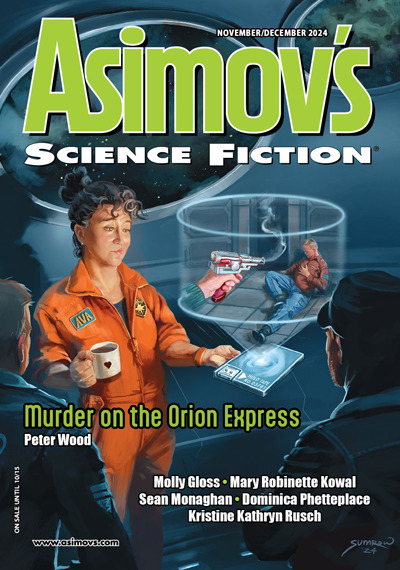
In a future where AI content is dominating social media, Apple has a space station orbiting the Moon and have sent two social media stars up there to create original real content. The influencers are Zephyr and Seven, and while they apparently did had more than a year of training, they are for the most part far from real astronauts. With them they have Daniels, a proper astronaut and the onboard AI called Mentor. As these stories go, something goes wrong as the station gets hit by micrometeorites and one of the influencer will need to step up their game.
While the story is pretty recognizable for anyone familiar with these type of rescue stories, which normally mostly gets printed in Analog, I most admit I was fully engrossed in the exciting drama that unfolded over the pages. It has proper tension and interesting characters within the limitations of a short story length.
Read in Asimov’s November/December 2024
Rating: 3 -
Mirrorstar by Sean McMullen
A new Sean McMullen story is always and one that delivers a fresh original angle on first contact is even better. Like in “Saving Galileo” telescopes are central to the plot. Only this time much much bigger. Size of a planet times bigger.

We follow Dr. Connell on the large telescope construction Mirrorstar that is built in the outer skirts of the solar system. Humans have observed similar gigantic telescopes in other solar system and have decide to build one too. It is tracking a planet 33 light years away and the story begins with Connell being informed of a dead crew-member and he has to investigate what is the first death on this mission so far.
The dead crew-member appears frozen, but maybe she is not entirely dead. She appears to have been changed through something coming through the giant telescope from the far away planet. While this may sound a bit like a horror setup, it fits mostly within the hard sf category. There is a methodical approach to events with logical conclusions.
What especially shines is the depth of the characters. All with interesting back stories and well developed personalities with strength and weaknesses. As much as I enjoyed the concept McMullen presents here, I do wish he could have used for something greater. But this may very well be just a first setup for following stories on Mirrorstar.
Read in Analog November/December 2024
Rating: 4